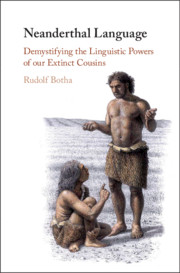Book contents
- Neanderthal Language
- Neanderthal Language
- Copyright page
- Contents
- Figures
- Images
- Acknowledgements
- Copyright Permission for Images
- Part I Preliminaries
- Part II Symbolic Behaviours
- Part III Non-symbolic Behaviours
- 8 Making Stone Tools
- 9 Teaching Stone-Tool Making
- 10 Hunting Big Game
- Part IV Implications
- Notes
- References
- Index
9 - Teaching Stone-Tool Making
from Part III - Non-symbolic Behaviours
Published online by Cambridge University Press: 26 April 2020
- Neanderthal Language
- Neanderthal Language
- Copyright page
- Contents
- Figures
- Images
- Acknowledgements
- Copyright Permission for Images
- Part I Preliminaries
- Part II Symbolic Behaviours
- Part III Non-symbolic Behaviours
- 8 Making Stone Tools
- 9 Teaching Stone-Tool Making
- 10 Hunting Big Game
- Part IV Implications
- Notes
- References
- Index
Summary
Chapter 9 focuses on an inference about Neanderthal language drawn from data about the experimental teaching of stone-tool making to modern humans. Comprising three inferential steps, the knapping-pedagogy inference looks as follows in outline: Experimentally gathered data about the transmission of Oldowan technology to modern humans → Verbal language enhances the transmission of Oldowan technology to modern humans → Verbal language originated hundreds of thousands years ago as a prerequisite for Acheulean technology → Some Neanderthals had verbal language. There are various reasons for doubting the soundness of this inference. First, its empirical grounding is contentious: some experimental studies have found verbal interaction to be unnecessary for teaching knapping skills, even causing underperformance by modern learners. Second, Chapter 9 finds the inferential steps to lack the required logical force. For instance, it cannot be inferred that verbal language was a prerequisite for teaching knapping technology to modern humans from data that it only enhances the teaching of such technology to modern humans. This logical flaw leaves the final inferential step ungrounded.
- Type
- Chapter
- Information
- Neanderthal LanguageDemystifying the Linguistic Powers of our Extinct Cousins, pp. 122 - 127Publisher: Cambridge University PressPrint publication year: 2020

